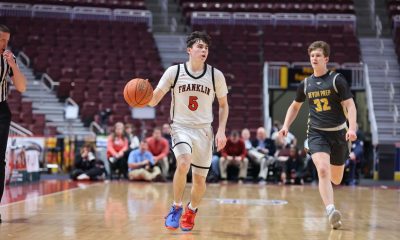
INDIANAPOLIS – The National Federation of High School Sports (NFHS) on Monday announced a change in the rules governing free throws in high school basketball, although the PIAA will have final say on whether the rule change will be used in Pennsylvania.
The change eliminates the one-and-one from the game and team fouls being counted by halves. Previously, teams were awarded the one-and-one bonus when their opponents committed seven fouls in a half and two foul shots when 10 fouls were committed each half.
Instead, teams will reach the “double bonus” or two free throws if their opponent commits five fouls in each quarter. and that will reset in every quarter.
The change was approved by the NFHS Basketball Rule Committee at its annual meeting April 24-26 in Indianapolis, and the recommendation was subsequently approved by the NFHS Board of Directors. The new free-throw rule would go into effect for the 2023-24 basketball season.
While the NFHS has approved the rule change, in order for it to become part of high school basketball in Pennsylvania the PIAA has to approve the change as well, according to a Tweet from Bob Greenburg of Sports Radio 96.7 FM in Mercer.
Greenburg reached out to PIAA executive director Bob Lombardi, who told him that the PIAA approves all sports rules for each school year at its July PIAA Board meeting.
Lombardi told Greenburg that the “PIAA adopts most NFHS rules but has modified them where the Board deems appropriate.”
PIAA’S BOB LOMBARDI:
The Board approves all sports rules for each school year at their July meeting. This gives our schools, coaches & officials an opportunity to provide feedback through their various committees. So final word will come out of the summer July Board meeting…..— Bob Greenburg (@BobGreenburg) May 15, 2023
The NFHS pointed to safety as being the motivating factor behind the rule change.
“The rules committee studied data that showed higher injury rates on rebounding situations and saw this as an opportunity to reduce opportunities for rough play during rebounds,” said Lindsey Atkinson, NFHS Director of Sports and liaison to the Basketball Rules Committee. “Additionally, resetting the fouls each quarter will improve game flow and allow teams to adjust their play by not carrying foul totals to quarters two and four.”
According to USA Basketball, the one-and-one was first introduced to the game in 1954.
The NFHS’s rule change brings the organization in line with women’s college basketball, although men’s college basketball still uses the one-and-one. Neither the NBA nor FIBA have a one-and-one rule, either.
Additional rule changes approved by the NFHS include:
•Rule 2-1-3 establishes the official placement of a shot clock operator at the scorer’s table for those states utilizing the shot clock. (Pennsylvania currently does not use the shot clock, although New York does)
•Rule 3-4-5 clarifies that multiple styles of uniform bottoms may be worn by teammates, but they must all be like-colored and adhere to uniform rules outlined in Rule 3-6-2 regarding logos and trademarks.
•Rule 3-5-6 addresses undershirts and allows teams to wear a single solid color or solid black for visiting teams with dark jerseys. This provides an opportunity for schools with hard-to-find colors to have all players wear a black undershirt.
•Rule 9-3-3 was amended to allow a player to step out of bounds and return to the court if the player gains no advantage. A player is penalized only if, after returning inbounds, the player is the first to touch the ball or avoids a violation.
•Rule 7-5-2 thru 5: Establishes four throw-in spots (the nearest 28-feet mark along each sideline or the nearest spot (3) feet outside the lane line on the end line) when the ball is in team control in the offensive team’s frontcourt and the defensive team commits a violation, a common foul prior to the bonus, or the ball becomes dead.
•Rule 7-6-6: Allows the official administering a throw-in to the wrong team to correct the mistake before the first dead ball after the ball becomes live unless there is a change of possession.
•Rule 9-3-3: Establishes that a player may step out of bounds without penalty unless they are the first player to touch the ball after returning to the court or if they left the court to avoid a violation.



















